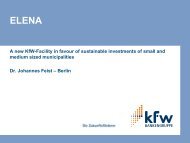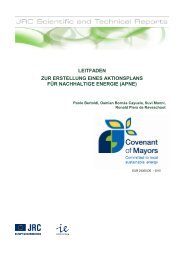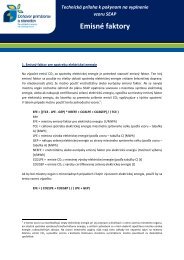English - Covenant of Mayors
English - Covenant of Mayors
English - Covenant of Mayors
Create successful ePaper yourself
Turn your PDF publications into a flip-book with our unique Google optimized e-Paper software.
3.4 Electricity<br />
In order to calculate the CO 2<br />
emissions to be attributed to<br />
electricity consumption, it is necessary to determine which<br />
emission factor is to be used. The same emission factor will<br />
be used for all electricity consumption in the territory,<br />
including that in rail transportation. The local emission factor<br />
for electricity may take the following components into<br />
consideration. The contribution <strong>of</strong> each <strong>of</strong> them in the<br />
estimation <strong>of</strong> the local emission factor is explained in more<br />
detail in the Sections below:<br />
1. National/European emission factor.<br />
2. Local electricity production.<br />
3. Purchases <strong>of</strong> certified green electricity by the local authority.<br />
Because the estimation <strong>of</strong> emissions from electricity is<br />
based on electricity consumption, the emission factors are<br />
expressed as t/MWhe. Therefore, the corresponding<br />
activity data to be used has also to be in the form <strong>of</strong> MWhe,<br />
i.e. in MWh <strong>of</strong> electricity consumed.<br />
3.4.1 National or European emission factor<br />
Electricity is consumed in the territory <strong>of</strong> each local authority,<br />
but the main units that produce it are only concentrated on<br />
the territory <strong>of</strong> a few <strong>of</strong> them. These major production units<br />
are <strong>of</strong>ten large CO 2<br />
emitters (in the case <strong>of</strong> fossil fuel thermal<br />
plants), but their electricity production is not meant to cover<br />
only the electricity needs <strong>of</strong> the municipality on which they<br />
are built, but the needs <strong>of</strong> a larger area. In other words, the<br />
electricity that is consumed in a particular municipality<br />
generally comes from different plants either inside or outside<br />
the municipality. As a consequence, the CO 2<br />
that is emitted<br />
due to this electricity consumption actually comes from those<br />
various plants. To quantify this for each individual municipality<br />
would be a challenging task, as the physical flows <strong>of</strong><br />
electricity cross the borders and vary depending on several<br />
factors. In addition, the municipalities in question usually have<br />
no control on the emissions <strong>of</strong> such plants. For these<br />
reasons, and keeping in mind that the focus <strong>of</strong> the <strong>Covenant</strong><br />
<strong>of</strong> <strong>Mayors</strong> is on the demand (consumption) side, it is recommended<br />
to use a national or European emission factor as<br />
a starting point to determine the local emission factor. This<br />
emission factor reflects the average CO 2<br />
emissions related<br />
to the national or European electricity production.<br />
The national and European emission factors fluctuate from<br />
year to year due to energy mix used in electricity generation.<br />
These fluctuations are caused by the heating/cooling<br />
demand, availability <strong>of</strong> renewable energies, energy market<br />
situation, import/export <strong>of</strong> energy and so on. These fluctuations<br />
occur independently <strong>of</strong> the actions taken by the local<br />
authority. Therefore, it is recommended to use the same<br />
emission factor in the BEI and in the MEI, because otherwise<br />
the result <strong>of</strong> the emission inventory could be very sensitive<br />
to factors on which the local authority has no influence.<br />
The local authority may decide to use either a national or<br />
European emission factor. The emission factors for standard<br />
and LCA approaches are presented in Table 5 for all the<br />
Member States (except Malta and Luxembourg for which the<br />
data were not available) and the EU as a whole. The local<br />
authority is welcome to search for more up-to-date data. Note<br />
that LCA emission factors should in all the cases be higher<br />
than standard emission factors. However, due to different<br />
data sources used and different years covered by the two<br />
sets <strong>of</strong> emission factors, the standard and LCA emission<br />
factors are not necessarily comparable, which is especially<br />
visible in the cases <strong>of</strong> Poland and the Czech Republic.<br />
TABLE 5. NATIONAL AND EUROPEAN EMISSION<br />
FACTORS FOR CONSUMED ELECTRICITY<br />
COUNTRY<br />
STANDARD<br />
EMISSION FACTOR<br />
(t CO 2<br />
/MWh e<br />
)<br />
LCA EMISSION<br />
FACTOR<br />
(t CO 2<br />
-eq/MWh e<br />
)<br />
Austria 0.209 0.310<br />
Belgium 0.285 0.402<br />
Germany 0.624 0.706<br />
Denmark 0.461 0.760<br />
Spain 0.440 0.639<br />
Finland 0.216 0.418<br />
France 0.056 0.146<br />
United Kingdom 0.543 0.658<br />
Greece 1.149 1.167<br />
Ireland 0.732 0.870<br />
Italy 0.483 0.708<br />
Netherlands 0.435 0.716<br />
Portugal 0.369 0.750<br />
Sweden 0.023 0.079<br />
Bulgaria 0.819 0.906<br />
Cyprus 0.874 1.019<br />
Czech Republic 0.950 0.802<br />
Estonia 0.908 1.593<br />
Hungary 0.566 0.678<br />
Lithuania 0.153 0.174<br />
Latvia 0.109 0.563<br />
Poland 1.191 1.185<br />
Romania 0.701 1.084<br />
Slovenia 0.557 0.602<br />
Slovakia 0.252 0.353<br />
EU-27 0.460 0.578<br />
Note that the year which the data represents varies between countries<br />
and between standard and LCA approach (6).<br />
13<br />
(6) Sources for standard emission factors: Germany: http://www.umweltbundesamt.de/energie/archiv/co2-strommix.pdf (year 2007); Denmark: Average <strong>of</strong><br />
emission factors for Eastern and Western Denmark including distribution loss <strong>of</strong> 5 %. http://www.energinet.dk/en/menu/Climate+and+the+environment/Env<br />
ironmental+impact+statements+for+electricity/Environmental+impact+statements+for+electricity.htm (year 2008); Estonia: personal communication<br />
with Estonian Environment Information Centre (year 2007); Portugal: personal communication with Portuguese Agency for the Environment (year 2007); Slovenia:<br />
Personal communication with Environmental Agency <strong>of</strong> the Republic <strong>of</strong> Slovenia (year 2007); Slovakia: Personal communication with Slovak Hydrometeorological<br />
Institute (year 2007); Spain: personal communication with Ministry <strong>of</strong> Environment, Spain (year 2007); United Kindom: personal communication with Department<br />
<strong>of</strong> Energy and Climate Change (year 2007); other countries and European average: Eurelectric (2005), (available years 2000-2002). Source for LCA emission<br />
factors: European Reference Life Cycle Database (ELCD), http://lca.jrc.ec.europa.eu/lcainfohub/datasetArea.vm (year 2002).












